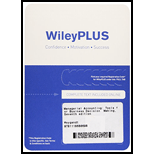
(a)
Sell or process-further decision:
The purpose of sell or process-further decision is to choose an appropriate alternative that maximizes the operating income. It uses incremental analysis which determines the incremental revenue.
Incremental revenue refers to the difference in the total revenue earned when the product or service is sold at split-off point and the total revenue earned when the product or service is sold after further processing.
If the incremental revenue is more than the incremental costs, the product should be sold after further processing. If the incremental revenue is lesser than the incremental costs, the product should be sold at split-off point.
To explain: The information relevant to the decision on whether to further process the products or not, and the reason behind it.
(b)
Split-off Point:
Split-off point is referred to as the point at which the joint products will become individually identifiable as the separate products.
To determine: The products to be processed further, and the products to be sold at the split-off point.
(c)
Decision-making process:
Decision making can be defined as the process of making choices through the identification of a decision, collecting information, and assessing alternative resolutions. The implementation of a step-by-step process of decision making helps in making deliberate and effective decisions through proper organization of relevant information and defining alternatives.
To Explain: Whether the decision would be different if the company was using the quantity of output to allocate the joint costs.
Want to see the full answer?
Check out a sample textbook solution
Chapter 7 Solutions
Managerial Accounting: Tools For Business Decision Making, Seventh Edition Wileyplus Card
- Financial Accounting Question please answerarrow_forwardHow much of every retail sales dollar is made up of merchandise cost on these general accounting question?arrow_forwardThe company where Daniel works produces skateboards locally but sells them globally for $60 each. Daniel is one of the production managers in a meeting to discuss preliminary results from the year just ended. Here is the information they had in front of them: Standard Quantity per Unit Standard Price Wood 2.50 feet $4.00 per foot Wheels 5.00 wheels $0.50 per wheel Direct labor 0.30 hours $14.00 per hour Actual results: . • Quantity of wood purchased, 225,000 feet; quantity of wood used, 220,000 feet. Quantity of wheels purchased, 418,800 wheels; quantity of wheels used, 400,800 wheels. Actual cost of the wood, $4.20 per foot. Actual cost of the wheels, $0.55 per wheel. • Quantity of DL hours used, 26,400 hours; actual cost of DL hours, $15.20 per hour. Actual units produced, 80,000 skateboards. (a) Complete a variance analysis for DM (both wood and wheels) and DL, determining the price and efficiency variances for each; be sure to specify the amount and sign of each variance. DM- Wood…arrow_forward
- Principles of Accounting Volume 2AccountingISBN:9781947172609Author:OpenStaxPublisher:OpenStax College
 Cornerstones of Cost Management (Cornerstones Ser...AccountingISBN:9781305970663Author:Don R. Hansen, Maryanne M. MowenPublisher:Cengage Learning
Cornerstones of Cost Management (Cornerstones Ser...AccountingISBN:9781305970663Author:Don R. Hansen, Maryanne M. MowenPublisher:Cengage Learning

